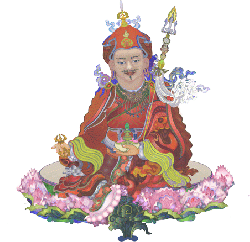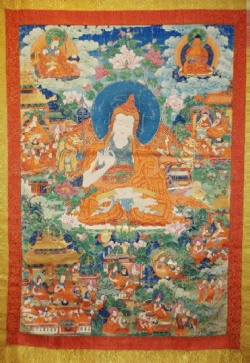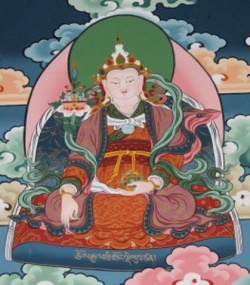Difference between revisions of "History of Nyingma Buddhism"
| Line 1: | Line 1: | ||
| + | {{SeealsoDPL/button}} | ||
[[File:Padma VTao.gif|thumb|250px|]] | [[File:Padma VTao.gif|thumb|250px|]] | ||
| + | |||
| + | |||
| + | |||
| + | |||
| + | |||
<poem> | <poem> | ||
There are four major [[schools of Tibetan Buddhism]]: | There are four major [[schools of Tibetan Buddhism]]: | ||
| Line 8: | Line 14: | ||
[[Gelug]] (founded in 1409 A.D.) | [[Gelug]] (founded in 1409 A.D.) | ||
| − | Besides these four major schools, there was also an important 19th c. development in [[Tibetan]] Buddhism known as the “[[Rime]] | + | Besides these four major schools, there was also an important 19th c. [[development]] in [[Tibetan]] [[Buddhism]] known as the “[[Rime]] {{Wiki|Movement}}” (pronounced ree’-mey). ”[[Rime]]” means “no sides” or “[[non-sectarian]].” It arose partly in {{Wiki|reaction}} to {{Wiki|sectarianism}} fostered by the {{Wiki|domination}} of the [[Gelug]] [[views]] in the {{Wiki|culture}} and {{Wiki|politics}} in [[Tibet]], because of which other schools felt their unique [[character]] and styles were threatened. In an [[effort]] to preserve the comparatively smaller [[traditions]], the [[Rime]] {{Wiki|movement}} was founded on the [[ancient]] [[Buddhist]] [[idea]] that it is wrong to ignorantly criticize other [[traditions]] or [[religions]]. This {{Wiki|movement}} gathers and incorporates teachings from all of the [[Buddhist]] schools and the major [[non-Buddhist]] [[Tibetan]] [[tradition]] called [[Bon]], and [[Rime]] practitioners follow multiple [[lineages]] and practices. [[Rime]] is not an [[effort]] to unite the various schools, rather an [[effort]] to [[recognize]] and appreciate their differences, and their unique and valuable contributions. |
[[File:Shantarakshita01.jpg|thumb|250px|]] | [[File:Shantarakshita01.jpg|thumb|250px|]] | ||
| − | The [[word]] “[[Nyingma]]” means “[[ancient]],” referring to the school’s characteristic of being the oldest among all of [[Tibet’s]] [[Buddhist]] traditions. Often called the “[[ancient translation school]],” the [[Nyingma]] lineage began in the latter part of the 8th c. when the [[Tibetan King]] [[Trisong Detsen]] invited both the renowned [[Indian]] [[guru]] [[Shantarakshita]], [[abbot]] of the great [[Buddhist]] [[Nalanda]] University, and the [[tantric]] master [[Padmasambhava]], to come to [[Tibet]] and introduce [[Buddhism]] to his people. [[Shantarakshita]], [[Padmasambhava]], the [[Indian]] master [[Vimalamitra]], the [[Tibetan]] translator [[Vairochana]], along with [[108]] translators and 25 of [[Padmasambhava’s]] closest students, undertook this monumental task of rendering all of the extant [[Buddhist]] scriptures into [[Tibetan]] from [[Sanskrit]], and accomplished it in one generation. In addition to the translation of the [[tantras]] (the esoteric teachings of the [[Buddha]]), supervised mainly by [[Padmasambhava]], and the [[sutras]] (oral teachings of the [[Buddha]]) supervised mainly by [[Shantarakshita]], these two also founded [[Tibet’s]] first [[Buddhist]] [[monastery]], [[Samye]], which became the main center for [[Buddhist]] teaching in [[Tibet]] for the next 300 years. | + | The [[word]] “[[Nyingma]]” means “[[ancient]],” referring to the school’s [[characteristic]] of being the oldest among all of [[Tibet’s]] [[Buddhist]] [[traditions]]. Often called the “[[ancient translation school]],” the [[Nyingma]] [[lineage]] began in the [[latter]] part of the 8th c. when the [[Tibetan King]] [[Trisong Detsen]] invited both the renowned [[Indian]] [[guru]] [[Shantarakshita]], [[abbot]] of the great [[Buddhist]] [[Nalanda]] {{Wiki|University}}, and the [[tantric]] [[master]] [[Padmasambhava]], to come to [[Tibet]] and introduce [[Buddhism]] to his [[people]]. [[Shantarakshita]], [[Padmasambhava]], the [[Indian]] [[master]] [[Vimalamitra]], the [[Tibetan]] [[translator]] [[Vairochana]], along with [[108]] [[translators]] and 25 of [[Padmasambhava’s]] closest students, undertook this monumental task of rendering all of the extant [[Buddhist]] [[scriptures]] into [[Tibetan]] from [[Sanskrit]], and accomplished it in one generation. In addition to the translation of the [[tantras]] (the [[esoteric teachings]] of the [[Buddha]]), supervised mainly by [[Padmasambhava]], and the [[sutras]] ([[oral teachings]] of the [[Buddha]]) supervised mainly by [[Shantarakshita]], these two also founded [[Tibet’s]] first [[Buddhist]] [[monastery]], [[Samye]], which became the main center for [[Buddhist]] [[teaching]] in [[Tibet]] for the next 300 years. |
| − | These events formed the basis of the early dissemination of Buddhism in [[Tibet]] up to the 11th century, which did not all proceed smoothly. Political instability followed the succession of the anti-Buddhist [[king]] [[Langdarma]] (836–842) and his subsequent assassination. The persecution of [[Buddhism]] under [[Langdarma]] and later local leaders was such that most [[Buddhist]] practice was forced underground. When in the 11th century the persecution abated, new lineage transmissions from [[Indian]] to [[Tibetan]] masters [[caused]] new schools of [[Buddhism]] to rise, including the [[Kagyu]], [[Sakya]], and much later, the [[Gelug]], mentioned above. When this began to happen, members of the existing school began to see themselves as a distinct group, identifying themselves as followers of the “[[ancient]]” or “[[Nyingma]]” tradition, as contrasted to the “[[Sarma]]” or” new” [[traditions]]. | + | These events formed the basis of the early dissemination of [[Buddhism]] in [[Tibet]] up to the 11th century, which did not all proceed smoothly. {{Wiki|Political}} instability followed the succession of the anti-Buddhist [[king]] [[Langdarma]] (836–842) and his subsequent assassination. The persecution of [[Buddhism]] under [[Langdarma]] and later local leaders was such that most [[Buddhist]] practice was forced underground. When in the 11th century the persecution abated, new [[lineage]] [[transmissions]] from [[Indian]] to [[Tibetan]] [[masters]] [[caused]] new schools of [[Buddhism]] to rise, including the [[Kagyu]], [[Sakya]], and much later, the [[Gelug]], mentioned above. When this began to happen, members of the [[existing]] school began to see themselves as a {{Wiki|distinct}} group, identifying themselves as followers of the “[[ancient]]” or “[[Nyingma]]” [[tradition]], as contrasted to the “[[Sarma]]” or” new” [[traditions]]. |
[[File:King-trisong-detsen2.jpg|thumb|250px|]] | [[File:King-trisong-detsen2.jpg|thumb|250px|]] | ||
| − | The four major schools of [[Tibetan]] Buddhism differ in their size, political [[ethos]], emphasized practices, and of course, lineage. Unlike the other three major schools, supporters of the [[Nyingma tradition]] rarely held political power in [[Tibet]], generally preferring to remain at a distance from [[Tibetan]] political concerns. Traditionally, the [[Nyingma]] had no centralized authority. It is only since the Chinese invasion of [[Tibet]] that the [[Dalai Lama]] politely requested that the [[Nyingma]] followers recognize someone to represent them within the [[Tibetan]] government-in-exile. Other then that, the [[Nyingma tradition]] remains politically decentralized. Decisions are often made by a community of the senior practitioners within a given locale. [[Nyingma]] followers are historically distinguished from other schools of Buddhism by their categorization of the spiritual [[path]] into nine progressively more subtle [[yanas]], or vehicles, and the unique ninth vehicle called [[Dzogchen]], or the “[[Great Perfection]].” Within the [[Nyingma]] are also two distinct communities of monastics and lay [[tantric]] practitioners (Tib. [[ngakpa]]). | + | The four major schools of [[Tibetan]] [[Buddhism]] differ in their size, {{Wiki|political}} [[ethos]], emphasized practices, and of course, [[lineage]]. Unlike the other three major schools, supporters of the [[Nyingma tradition]] rarely held {{Wiki|political}} power in [[Tibet]], generally preferring to remain at a distance from [[Tibetan]] {{Wiki|political}} concerns. [[Traditionally]], the [[Nyingma]] had no centralized authority. It is only since the [[Wikipedia:Battle of Chamdo|Chinese invasion]] of [[Tibet]] that the [[Dalai Lama]] politely requested that the [[Nyingma]] followers [[recognize]] someone to represent them within the [[Tibetan]] government-in-exile. Other then that, the [[Nyingma tradition]] remains {{Wiki|politically}} decentralized. Decisions are often made by a {{Wiki|community}} of the senior practitioners within a given locale. [[Nyingma]] followers are historically {{Wiki|distinguished}} from other [[schools of Buddhism]] by their categorization of the [[spiritual]] [[path]] into nine progressively more {{Wiki|subtle}} [[yanas]], or vehicles, and the unique ninth [[vehicle]] called [[Dzogchen]], or the “[[Great Perfection]].” Within the [[Nyingma]] are also two {{Wiki|distinct}} communities of [[monastics]] and lay [[tantric]] practitioners (Tib. [[ngakpa]]). |
| − | While the other three major schools have traditionally recognized spiritual and political heads: | + | While the other three major schools have [[traditionally]] [[recognized]] [[spiritual]] and {{Wiki|political}} heads: |
[[The Dalai Lama]] of the [[Gelug school]] (the newest school, having the largest population) | [[The Dalai Lama]] of the [[Gelug school]] (the newest school, having the largest population) | ||
| Line 22: | Line 28: | ||
The [[Sakya Trizin]] of the [[Sakya school]] | The [[Sakya Trizin]] of the [[Sakya school]] | ||
| − | the [[Nyingma school]] has only recognized such spiritual and political representatives since the 1960s after the invasion by the Chinese in 1950: | + | the [[Nyingma school]] has only [[recognized]] such [[spiritual]] and {{Wiki|political}} representatives since the 1960s after the invasion by the {{Wiki|Chinese}} in 1950: |
[[Dudjom Rinpoche]] (c. 1904–1987), served from the 1960s until his [[death]]. | [[Dudjom Rinpoche]] (c. 1904–1987), served from the 1960s until his [[death]]. | ||
| Line 33: | Line 39: | ||
[[Palyul Monastery]] | [[Palyul Monastery]] | ||
| − | There were six major monasteries upholding the [[Nyingma tradition]] in [[Tibet]]. Among them was [[Palyul Monastery]], established in 1665 in eastern [[Tibet]]. A [[lineage of Nyingma]] teachers arose from this [[monastery]], known as the [[Palyul Lineage]]. Like other schools of [[Tibetan Buddhism]], the [[Palyul Lineage]] of the [[Nyingma tradition]] is sustained by teachers and centres around the [[world]]. The recognized head of the [[Palyul tradition]] is currently His Holiness [[Karma Kuchen]] [[Rinpoche]], who succeeded his [[teacher]], His Holiness [[Penor Rinpoche]]. | + | There were six major [[monasteries]] upholding the [[Nyingma tradition]] in [[Tibet]]. Among them was [[Palyul Monastery]], established in 1665 in eastern [[Tibet]]. A [[lineage of Nyingma]] [[teachers]] arose from this [[monastery]], known as the [[Palyul Lineage]]. Like other schools of [[Tibetan Buddhism]], the [[Palyul Lineage]] of the [[Nyingma tradition]] is sustained by [[teachers]] and centres around the [[world]]. The [[recognized]] head of the [[Palyul tradition]] is currently [[His Holiness]] [[Karma Kuchen]] [[Rinpoche]], who succeeded his [[teacher]], [[His Holiness]] [[Penor Rinpoche]]. |
| − | Like all schools of [[Tibetan]] Buddhism, the [[Nyingma school]] recognizes those who make significant and precious contributions to the teachings of the [[Buddha]]. Among those so recognized by the [[Nyingma school]] are: | + | Like all schools of [[Tibetan]] [[Buddhism]], the [[Nyingma school]] [[recognizes]] those who make significant and [[precious]] contributions to the teachings of the [[Buddha]]. Among those so [[recognized]] by the [[Nyingma school]] are: |
| − | The most famous of all great scholars and [[tantric]] masters of the [[Nyingma]] lineage, besides [[Padmasambhava]] himself, is [[Longchenpa]] ([[Longchen Rabjam]]). Along with [[Rongzom Pandita]] and [[Jigme Lingpa]], [[Longchenpa]] is known as one of the | + | The most famous of all great [[scholars]] and [[tantric]] [[masters]] of the [[Nyingma]] [[lineage]], besides [[Padmasambhava]] himself, is [[Longchenpa]] ([[Longchen Rabjam]]). Along with [[Rongzom Pandita]] and [[Jigme Lingpa]], [[Longchenpa]] is known as one of the “[[omniscient ones]],” a rare title [[recognizing]] the infallibility of their [[wisdom]], [[knowledge]] and [[accomplishment]] in the teachings of the [[Buddha]]. [[Longchenpa]] wrote many commentaries on the whole [[body of Nyingma teachings]]. He is especially known for his presentation of [[Dzogchen]], which is the most [[precious]] and highly regarded practice in the [[Nyingma school]]. One of his most notable contributions was the systematization of the [[teaching]] and induction into the practice of [[Dzogchen]]. |
[[Jigme Lingpa]] (1730–1798) and the [[Longchen Nyingthig]] | [[Jigme Lingpa]] (1730–1798) and the [[Longchen Nyingthig]] | ||
Latest revision as of 13:56, 16 December 2015
Click here to see other articles relating to word History of Nyingma Buddhism
There are four major schools of Tibetan Buddhism:
Nyingma (founded 8th century A.D.)
Kagyu (founded in the early 11th century)
Sakya (founded in 1073 A.D.)
Gelug (founded in 1409 A.D.)
Besides these four major schools, there was also an important 19th c. development in Tibetan Buddhism known as the “Rime Movement” (pronounced ree’-mey). ”Rime” means “no sides” or “non-sectarian.” It arose partly in reaction to sectarianism fostered by the domination of the Gelug views in the culture and politics in Tibet, because of which other schools felt their unique character and styles were threatened. In an effort to preserve the comparatively smaller traditions, the Rime movement was founded on the ancient Buddhist idea that it is wrong to ignorantly criticize other traditions or religions. This movement gathers and incorporates teachings from all of the Buddhist schools and the major non-Buddhist Tibetan tradition called Bon, and Rime practitioners follow multiple lineages and practices. Rime is not an effort to unite the various schools, rather an effort to recognize and appreciate their differences, and their unique and valuable contributions.
The word “Nyingma” means “ancient,” referring to the school’s characteristic of being the oldest among all of Tibet’s Buddhist traditions. Often called the “ancient translation school,” the Nyingma lineage began in the latter part of the 8th c. when the Tibetan King Trisong Detsen invited both the renowned Indian guru Shantarakshita, abbot of the great Buddhist Nalanda University, and the tantric master Padmasambhava, to come to Tibet and introduce Buddhism to his people. Shantarakshita, Padmasambhava, the Indian master Vimalamitra, the Tibetan translator Vairochana, along with 108 translators and 25 of Padmasambhava’s closest students, undertook this monumental task of rendering all of the extant Buddhist scriptures into Tibetan from Sanskrit, and accomplished it in one generation. In addition to the translation of the tantras (the esoteric teachings of the Buddha), supervised mainly by Padmasambhava, and the sutras (oral teachings of the Buddha) supervised mainly by Shantarakshita, these two also founded Tibet’s first Buddhist monastery, Samye, which became the main center for Buddhist teaching in Tibet for the next 300 years.
These events formed the basis of the early dissemination of Buddhism in Tibet up to the 11th century, which did not all proceed smoothly. Political instability followed the succession of the anti-Buddhist king Langdarma (836–842) and his subsequent assassination. The persecution of Buddhism under Langdarma and later local leaders was such that most Buddhist practice was forced underground. When in the 11th century the persecution abated, new lineage transmissions from Indian to Tibetan masters caused new schools of Buddhism to rise, including the Kagyu, Sakya, and much later, the Gelug, mentioned above. When this began to happen, members of the existing school began to see themselves as a distinct group, identifying themselves as followers of the “ancient” or “Nyingma” tradition, as contrasted to the “Sarma” or” new” traditions.
The four major schools of Tibetan Buddhism differ in their size, political ethos, emphasized practices, and of course, lineage. Unlike the other three major schools, supporters of the Nyingma tradition rarely held political power in Tibet, generally preferring to remain at a distance from Tibetan political concerns. Traditionally, the Nyingma had no centralized authority. It is only since the Chinese invasion of Tibet that the Dalai Lama politely requested that the Nyingma followers recognize someone to represent them within the Tibetan government-in-exile. Other then that, the Nyingma tradition remains politically decentralized. Decisions are often made by a community of the senior practitioners within a given locale. Nyingma followers are historically distinguished from other schools of Buddhism by their categorization of the spiritual path into nine progressively more subtle yanas, or vehicles, and the unique ninth vehicle called Dzogchen, or the “Great Perfection.” Within the Nyingma are also two distinct communities of monastics and lay tantric practitioners (Tib. ngakpa).
While the other three major schools have traditionally recognized spiritual and political heads:
The Dalai Lama of the Gelug school (the newest school, having the largest population)
The Karmapa of the Kagyu school
The Sakya Trizin of the Sakya school
the Nyingma school has only recognized such spiritual and political representatives since the 1960s after the invasion by the Chinese in 1950:
Dudjom Rinpoche (c. 1904–1987), served from the 1960s until his death.
Dilgo Khyentse Rinpoche (c. 1910–1991), served from 1987 until his death.
Penor (Pema Norbu Rinpoche (1932–2009) served from 1991 until retirement in 2003.
Mindroling Trichen Rinpoche (c. 1930–2008), served from 2003 until his death.
Trulshik Rinpoche (1923–2011). Selected after Chatral Rinpoche declined the position.
Palyul Monastery
There were six major monasteries upholding the Nyingma tradition in Tibet. Among them was Palyul Monastery, established in 1665 in eastern Tibet. A lineage of Nyingma teachers arose from this monastery, known as the Palyul Lineage. Like other schools of Tibetan Buddhism, the Palyul Lineage of the Nyingma tradition is sustained by teachers and centres around the world. The recognized head of the Palyul tradition is currently His Holiness Karma Kuchen Rinpoche, who succeeded his teacher, His Holiness Penor Rinpoche.
Like all schools of Tibetan Buddhism, the Nyingma school recognizes those who make significant and precious contributions to the teachings of the Buddha. Among those so recognized by the Nyingma school are:
The most famous of all great scholars and tantric masters of the Nyingma lineage, besides Padmasambhava himself, is Longchenpa (Longchen Rabjam). Along with Rongzom Pandita and Jigme Lingpa, Longchenpa is known as one of the “omniscient ones,” a rare title recognizing the infallibility of their wisdom, knowledge and accomplishment in the teachings of the Buddha. Longchenpa wrote many commentaries on the whole body of Nyingma teachings. He is especially known for his presentation of Dzogchen, which is the most precious and highly regarded practice in the Nyingma school. One of his most notable contributions was the systematization of the teaching and induction into the practice of Dzogchen.
Jigme Lingpa (1730–1798) and the Longchen Nyingthig
Jigme Lingpa condensed Longchenpa’s systematization of Dzogchen into a series of specific practices and teachings called the Longchen Nyingthig, or “Heart Essence of the Vast Expanse”. This condensation became the foundation of the main Dzogchen teachings in the contemporary period, in both the Nyingma tradition and in the Rime (non-sectarian) movement.


